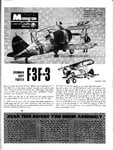MIflyer
1st Lieutenant
I am in the process of building Monogram's classic 1/32 F3F-3, trying to finally do one "right" after more than 50 years when I last tried, and that led to my recalling an article I read in an EAA publication years ago.
An F3F went into the Pacific Ocean and was fished out and sent back to the East coast for overhaul. When the overhaul was complete a ferry pilot made a long tortuous flight to take the airplane back to San Diego.
Arriving at his destination, he said he was happy to be rid of the airplane; it was terrible. It would not climb worth a darn, and cruised slowly despite its powerful R-1820 engine. The people at San Diego told him he was nuts.. The F3F was the hottest airplane around, It climbed like a rocket, better than anything else in the world. It cruised faster than most anything else the USN had, too. He had to be an incompetent pilot.
Then one grizzled old crew chief went out, looked at the airplane and came back, saying. "I don't doubt what he says. It is a tribute to that airplane that it flies at all. They set the prop blades up backwards. The prop is set up to work correctly but the curved trailing edges of the blades are all facing forward."
An F3F went into the Pacific Ocean and was fished out and sent back to the East coast for overhaul. When the overhaul was complete a ferry pilot made a long tortuous flight to take the airplane back to San Diego.
Arriving at his destination, he said he was happy to be rid of the airplane; it was terrible. It would not climb worth a darn, and cruised slowly despite its powerful R-1820 engine. The people at San Diego told him he was nuts.. The F3F was the hottest airplane around, It climbed like a rocket, better than anything else in the world. It cruised faster than most anything else the USN had, too. He had to be an incompetent pilot.
Then one grizzled old crew chief went out, looked at the airplane and came back, saying. "I don't doubt what he says. It is a tribute to that airplane that it flies at all. They set the prop blades up backwards. The prop is set up to work correctly but the curved trailing edges of the blades are all facing forward."

